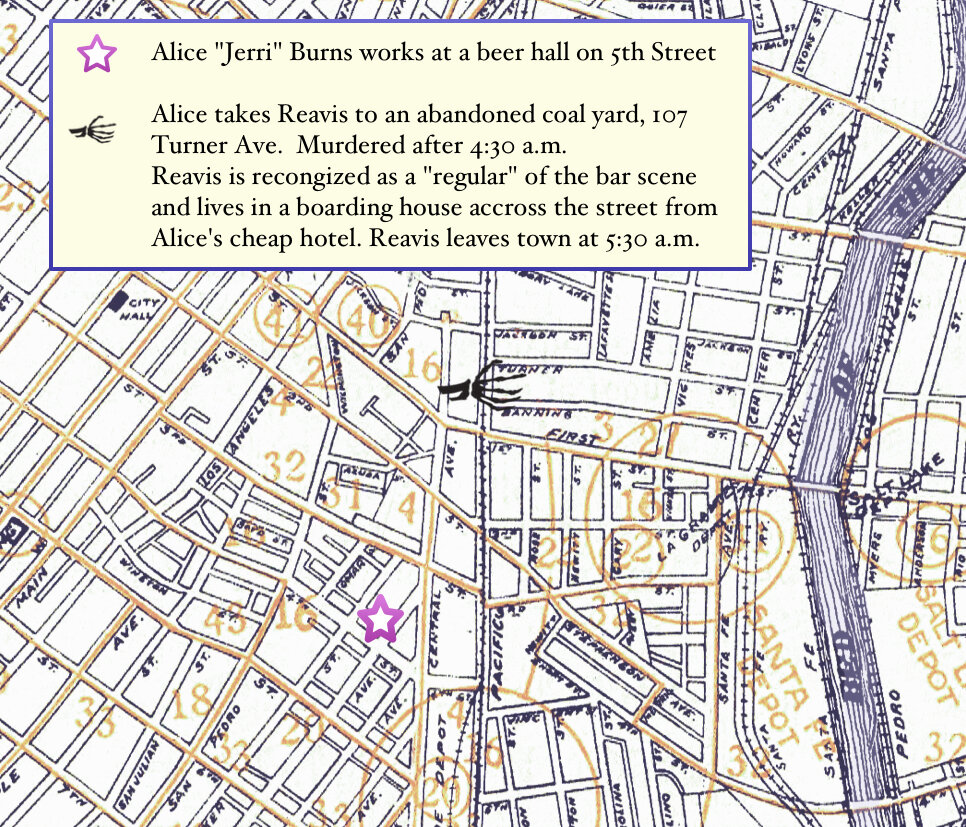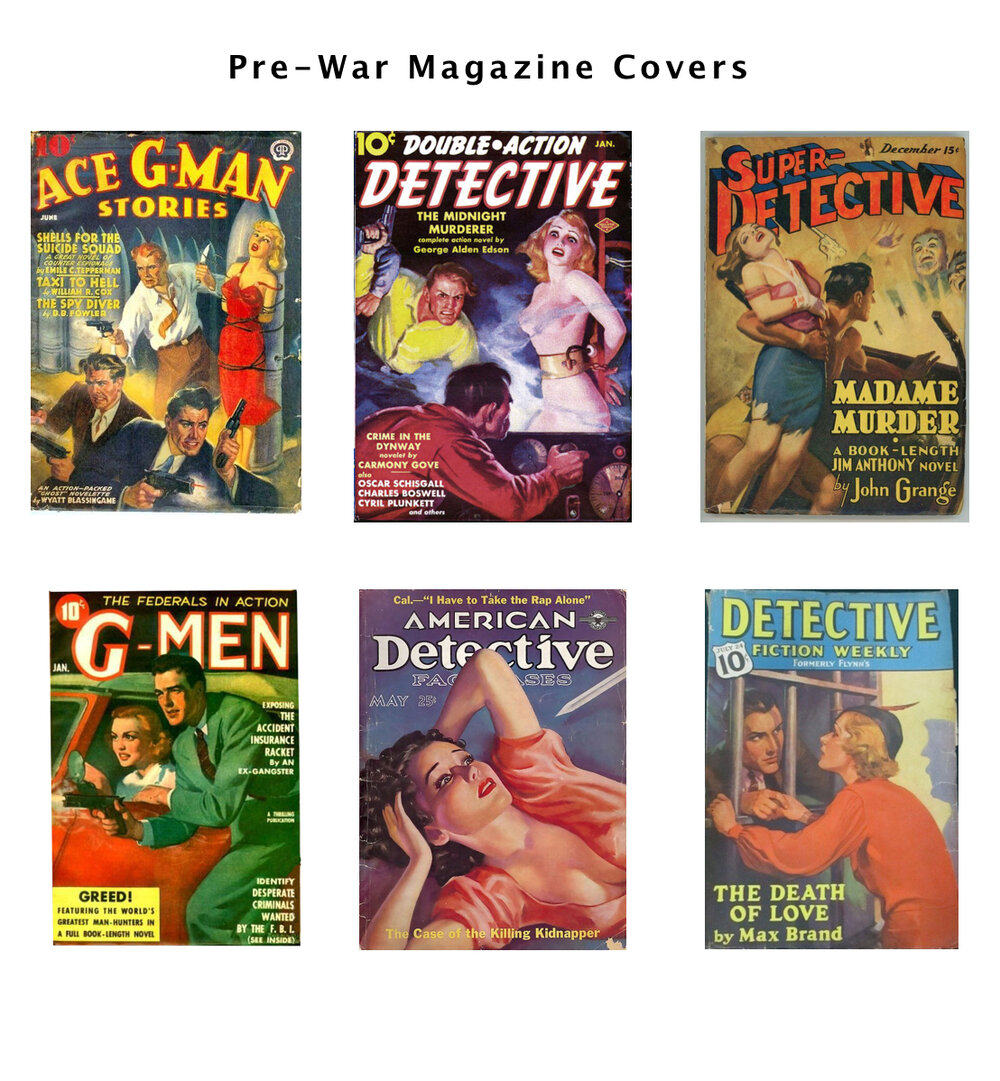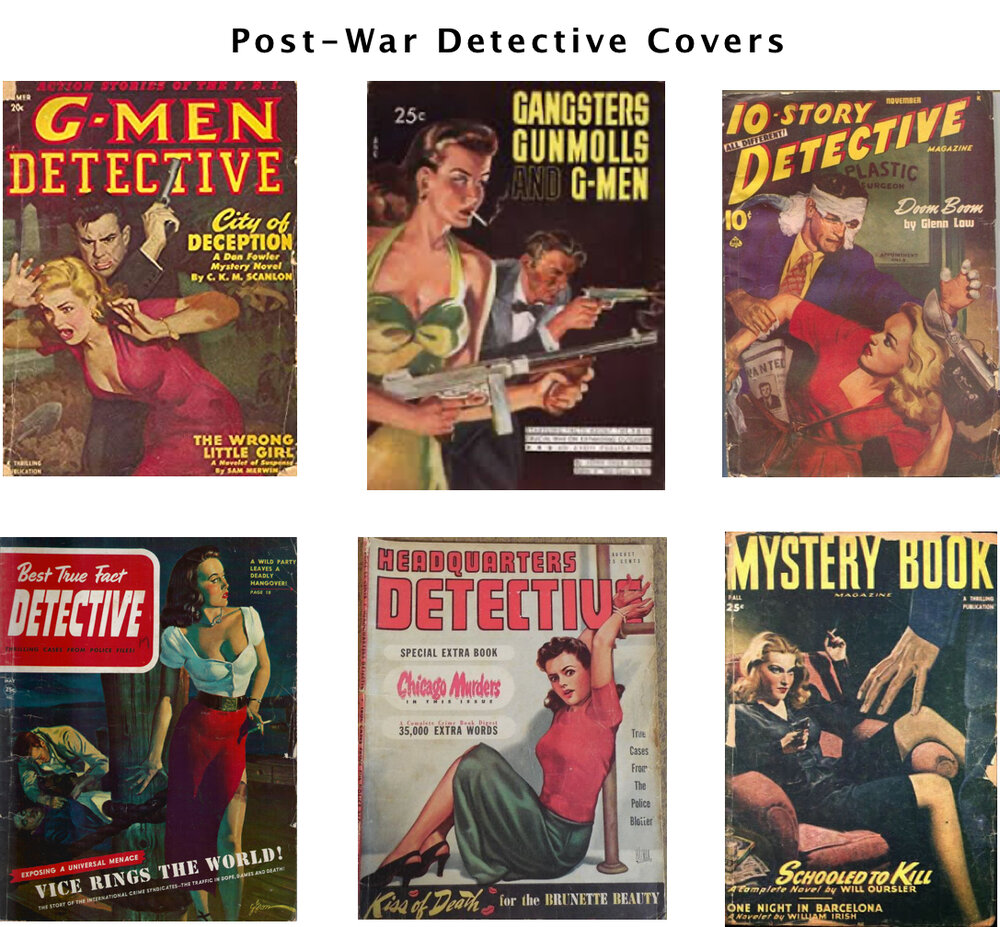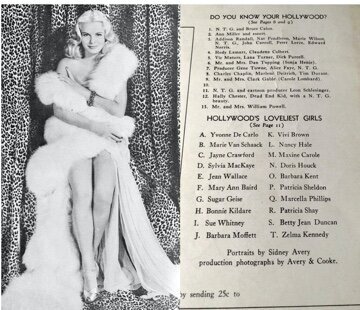EPISODE 7: Jan 24th
ซีรีส์ที่ถูกเก็บถาวร ("ฟีดที่ไม่ได้ใช้งาน" status)
When?
This feed was archived on October 01, 2021 08:11 (
Why? ฟีดที่ไม่ได้ใช้งาน status. เซิร์ฟเวอร์ของเราไม่สามารถดึงฟีดพอดคาสท์ที่ใช้งานได้สักระยะหนึ่ง
What now? You might be able to find a more up-to-date version using the search function. This series will no longer be checked for updates. If you believe this to be in error, please check if the publisher's feed link below is valid and contact support to request the feed be restored or if you have any other concerns about this.
Manage episode 273465460 series 2781331
Welcome to the Black Dahlia and the Blue Dahlia podcast. Episode 7 I am your host Scott Tracy.
in news today…
An unknown man threatened the life of Sultry Toni Smith, who now lives in the Hollywood apartment once shared by Miss Short. QUOTE The brunette beauty, her lips trembling with fear, said she answered the telephone in Apartment 501 last night to hear a strange man's gruff voice say: 'Well Toni. you are next.” "I honestly have no idea who he might have been. I don’t know why he should have threatened me.” * Miss Smith moved into Apartment 501 two weeks after Miss Short moved out. Fearful that she might be the next victim of the fiend who tortured Miss Short to death, then savagely hacked ...(her) in half. Miss Smith was given police protection. END-QUOTE
Toni Smith is a very photogenic non-Black Dahlia suspect. A person of interest for ten minutes. The press uses the word “sultry” as if it is Toni’s first name. In fact, Georgia is her first name. Toni is her actress name and she is a single mother of a three year old boy. I am not sure there would be much of a story in the paper without the accompanying photo of an ambitious and beautifully dressed actress sitting on the couch smiling with her long legs folded and posed underneath her body. Sultry Toni Smith appears to be auditioning for attention rather than trembling in fear. The Toni Smith story and this ‘actress as damsel in distress’ photo are not printed in the LA TIMES. However, because the Black Dahlia news is drying up. Many papers such as Bakersfield Californian, San Mateo Times believe the public is still thirsty for the sex and violence headlines of the Black Dahlia stories. It is amusing to imagine Sultry Toni Smith was ever a suspect;
Question of the day: raise your hand if believe the police think a Mother a of three year old boy, might be the dangerous Lesbian thespian they were seeking in the murder?
Interestingly, the Toni Smith story is put to use in some newspapers as part of the shift of the focus of the LAPD because a man telephoned Toni Smith. QUOTE Police, previously convinced that a woman was responsible, widened their search after hearing Miss Smith's story and finding other clues which pointed to a man. Police Lieutenant P. W. Freestone said be believed the killer in dumping the body onto a vacant lot early last Wednesday lowered one foot on a very small pool of blood on the ground, staining his shoe. He indicated the print was left by a man.
Other "tips" were telephoned to the homicide detail, ... A bloody towel was found (on) Hobart St. near 29th and was sent to the police crime laboratory for tests. A pair of nylon stockings picked up at 12th and Hoover; likewise were considered significant.
Let’s step back from the news and state the obvious. These stockings, the bloody towel and the threatened actress are all dead ends. We don’t hear about Sultry Toni again in the police blotter or on the big screen.
The thirst for news of the Black Dahlia has created significant pressure for new headlines. As the Black Dahlia Avenger has said to James Richardson yesterday, “you seem to have run out of material.” The Tortured Slain Nude Girl is what the public wants to read about. This is not lost on anyone in the publishing business. The Black Dahlia case plays a significant role in media historically as it changes the floor and the ceiling to what is permissible to show and tell the American public. From this point forward, the illustrated paperback covers for detective stories show more of the female figure. True Crime magazines change their covers and stories. On my web page I have a section of pre-war covers that are much more tame than the post-1947 covers. Pre war: Women in torn negligees, tied to the bedpost, Men with perfect hair and handguns are there to save them. Post war the images are raw. Women now have cigarettes, cleavage and Tommy guns. In five years, Paula Klaw will be selling pictures of Bettie Page based on customer requests for poses. There is no place for Pollyanna in this new detective world that embraces the threats of torture and bondage. As in Film Noir, the post war female is at the center of the spiderweb and a big part of the mystery is to find out if the woman is a victim or the spider. From an essay on True Crime magazines by Eric Godtland, QUOTE “In January 1947 a crime occurred that foreshadowed the direction of detective magazines for the remainder of their lifespan. The Black Dahlia murder case, involving the mutilation of a beautiful Hollywood starlet riveted the detective world. Horrible as it all was, the obvious sex appeal lurking in the backstory was not lost on publishers struggling to hold a shrinking readership.”**
Back to the news, Mrs. John Bersinger arrives at the University Police Station with her husband, wearing a fur coat. The paper states QUOTE…Mrs. John Bersinger, 3705 Norton Ave., volunteered that she was woman who first telephoned University Police Station on Jan. 15. “I was terribly shocked and scared to death," she said. QUOTE "I grabbed Anne and we walked as fast as we could to the first house that had a telephone. "When I called the police, they asked me what number I was talking from, and I gave it to them. They didn't ask me my name.”
We have covered this. I love that Betty Bersinger, gets dressed up to got to the police station. The newspapers were everything in 1947. It was exciting to be in the paper and be photographed. Of course she put on a fur coat, she is a star witness; she wanted to make her husband proud and look pretty. I have a photo essay on the press coverage of Mrs. Bersinger on my web site as the press brackets her pictures.
In the Los Angeles Times this day an article about a new witness…they refer to …a thin man. QUOTE Out of the shadows of the Norton Ave. "lovers lane," where the mutilated, nude body of Elizabeth Short was found in a weed-webbed vacant lot, a thin man walked yesterday into the case. This new character in the grisly murder story, … was pictured to police by Walter A. Johnson, 3815 Welland St.§
Two notes, first is it possible to tell this story without including the word “nude” but there it is for the reasons we just discussed. Second, Welland Avenue is seven blocks east of Norton so Walter Johnson drove over half mile at night to dump his lawn clipping among the weeds of a vacant lot.
Johnson said that at about 9 p.m. on Jan. 14 he went to the area, an undeveloped tract known as a haven for smoochers and trash haulers with a carload of shrub cuttings. As he slowed his car to a stop, he noticed a light colored 1935 model sedan parked on the west side of Norton directly opposite the fire plug near which Miss Short's body subsequently lay. The right rear door of the sedan was open. Standing near the car was the thin man, described by Johnson as 45 years of age, 5 feet 8 inches tall, thin build, wearing tan top coat and a dark hat pulled low. As Johnson stopped, the man looked up, startled. He then crossed the street and walked slowly past Johnson's car, hands in pockets. He scrutinized Johnson thoroughly and then craned look into Johnson's sedan. … At this point Johnson fearing the thin man was a bandit, drove away, circled the block, and returned to the spot. This time, he said the other car sped away with grinding gears and burning tires.
Let’s digest this — the other guy is parked on the wrong side of the street and neither of them expected to another person. Clearly the two men spooked each other. It’s 9 p.m. Beth Short is alive for at least six more hours. This has nothing to do with the Black Dahlia, this is only Norton Ave news, QUOTE a haven for smoochers and trash haulers. END-QUOTE What are you going to say to the wife? “Honey now that I finished mowing the lawn today, I’m in the mood for a bit of hanky-panky, let’s you and I drive around the corner to a special vacant lot I know..”
Honestly, it is a thick line between a dump and a lovers lane. Mr. Johnson didn’t go the the neighborhood to smooch. Let’s talk about a couple of things. One, criminals and lovers lanes, and two newspapers and lovers lanes.
Let’s begin with killers and lover’s lanes; is there any history of this, is a lover’s lane is a good dumping ground? No. Teenage lovers in cars and killers with a body in the trunk are seeking very different types of privacy and isolation. Historically, an isolated lover’s lane is where serial killers go shopping not dumping. Let’s name some lovers lane incidents. The Texarkana Moonlight Killer attacked four couples in cars over eight weeks from Feb 22nd thru May 3rd 1946 in isolated lovers lanes.
The Red Light Bandit, Carl Chessman robbed Regina Johnson and her date as they parked in isolation on a hill in west Pasadena on Jan 19th 1948.
The Zodiac killer shot teenage lovers Jensen and Faraday in their car on Lake Herman Road north of Benicia on December 20th 1968. The Valentine’s Day killings of Patricia Mann and Jesse McBane of Durham North Carolina, began with an abduction from a lover’s lane near Hillandale golf course. The lovers were found on February 25th 1971, ten days after their date and 4.2 miles from their car. They had been tortured but died fully clothed, tied to separate trees next to each other.
All of these killings seem to be murders of opportunity. There is little indication of a killer stalking these victims ahead of time. These “lover’s lanes” were isolated, not this classic high school movie trope of cars parked next to each other as they might be at a drive-in movie. None of these victims are killed elsewhere and taken to a lover’s lane to be dumped.
What can we learn from how newspapers used the words “Lover’s Lane”. In 1947 there are 8 instances of the words “lover’s lane” appearing together in the Los Angeles Times in the 12 months of the year. Thought it might be more but only 8 times.
On January 17th, 24th, 26th and 27th, the paper uses “lover’s lane” in reverence to Elizabeth Short.
On February 13th, lovers lane used in the report of the murder of Jeanie French.
On June 8th lovers lane used in a short story!
On Sept 13th, the bodies of 39 year old George Vigus and 21 year old Iris Scott are strangled and stuffed into the trunk of George’s Chevrolet coupe in a lover lane near Hyde Park in Toronto, Canada.
The Los Angeles Times Sunday edition had fiction included in the syndicated This Week † magazine on June 8th, and so a fictional undercover detective has to wait in the dark on a lonely bench in a park that is considered a lovers lane area, but his jealous girl friend follows him and melodramatic misunderstanding ensues. I expected the use of the words “Lover’s Lane” to be far more numerous, but nope. Opera Lovers, Garden Lovers, Film Lovers, Horse Lovers, Music Lovers and Bowling Lane. The big takeaway shocked me. The words “lover’s lane” are only used in the Los Angeles Times in a murder story. Astoundingly, all of the crimes involving lovers lanes were unsolved. In the Lone Women murders, the term lover’s lane is exclusively used for dump sites on the westside. Map on the web page.
I believe the press uses the term “lovers lane” to amplify drama and fear in the suburban public, as a “dog whistle” to parents so they worry about their teenagers.
However, the idea of the site being a lovers lane supplies a pseudo-motive for the killer and implies a relationship with the victim. Of course the logic fails, any person driving on Norton Ave. would see trash and weeds in the vacant lot; not lovers. What reason could there be to believe the killer knows of this location as a spot for “smoochers”?
If the killer lives in the neighborhood he might have seen someone parked there but if he lives in the neighborhood, Norton Ave. is a poor choice for a dump site, given the danger being recognized. The body is not placed on Norton by the killer because its a lovers lane; it’s called a lovers lane in the newspaper because a body is found there.
In contrast, how does the press coverage handle the non-suburban residential body dumps of other murders? Evelyn Winters is dumped near train tracks, and her warm dead body is kissed on the lips by the man that finds her but that dirt road is not called a lovers lane. After a late night of dance and drinks, Peter Hernandez forces himself on Angela Loya in an empty lot on Olympic between Sam Pedro and Alameda. Hernandez is a meat cutter by trade. Angela is raped, bludgeoned then disemboweled and dies on the way to the hospital. Lone women victims who are killed in east downtown are never given the implied title of lovers. Derelicts live in Skid Row. There are no shortage of Skid Row stories of sorrow and loss, but these events even when they are murder, are less significant news to citizens of the westside. There is no indication that kids necking in cars plays any significant role in the murder of Elizabeth Short. Beth was not killed because some man tried to get handsy in a parked car in Leimert Park and cut her in half and dumped her body in that same spot as a gravestone to his sexual frustration. Elizabeth Short is killed because she is a victim in the eyes of her torturer. The study of victimology is key to understanding this type of lust killer. Returning to the commentary of Sasha Reid; serial killers begin their lives as victims and have trouble making friends. Predators select victims that they can overpower. Consider the Lone Women Murders; Louis Springer was 99 pounds, Laura Treslad was 105 pounds, she is five foot four, Naomi Cook was 109 pounds, five foot two. Smaller victims are easier to control. Beth Short was 115 pounds, five foot five.
In 1946, the term lovers lane is used to describe the location of Gertrude Landon. On July 15th 1946 her body is found in half buried in a Gravel pit in Lomita, adjacent to Palos Verdes, five days after she disappeared. Gertrude is wearing only panties, brassiere, shoes and a diamond engagement ring. The Examiner, Times and Herald called the location a lovers lane, the body was found by 33-year-old Wilmington shipyard worker Theodore P. Walther hiking thru the area. Not a lovers lane. It is a gravel pit that no one visits in five days; a wise choice for an out of the way dump site. Once again a wealthy part of town like Palos Verdes is treated differently than skid row murder. Contrast the Landon murder with the Red Rose murder of 1939; on December 28th John Frank Reavis, trombone player and candy salesman drives “B” girl Alice Burns in his 1929 truck at 4:30 a.m. to an abandoned industrial coal yard lot south of Chinatown with the expectation of sex, Burns choses the isolated location as she is familiar with it. No newspaper will anoint the location as a lover’s lane.
The Skid Row section of downtown Los Angeles is the birthplace of the disposable victim trope we see in television and movies today. Jerry Burns worked in a cheap beer tavern, she lived in Skid Row hotel was killed in the shadows of the downtown railroad yards.
Yet, it could be said that 17 year old Jerri Alice Burns had fuller life than Elizabeth Short. “Jerri” Burns had a job, a husband and home in San Bernardino. But she can’t die in a lovers lane because the 17 year old was blond temptress who would induce lonely drunks to drink to excess. Newspapers can’t give Jerri Burns a character arc because the public sees her as a sex worker not as a sexy actress. The Los Angeles Times listed her occupation as a Skid Row Entertainer. The Arizona Republic called her a Taxi Dancer, the Texas Record called her a barroom hostess, the Wilmington Press, defines Jerri Burns by the Skid Row neighborhood, calling her an East-side Entertainer, whatever that is supposed to mean; it’s rather like calling Sally Rand a “Ballon Artist”. San Bernardino Sun says she was employed at a 5th street bar and lived in an East Side semi-slum neighborhood. Slum dwellers don’t get a character arc in the newspapers, even if they are entertaining.
The character arc for Beth Short is invented from the very beginning. Jack Smith tells the story in his memoirs. “..as a rewrite man for the Daily News in 1947 "Within the minute I had written what may have been the first sentence ever written on the Black Dahlia case.. I can't remember it word for word, but my lead went pretty much like this: 'The nude body of a young woman, neatly cut in two at the waist, was found early today on a vacant lot near Crenshaw and Exposition Boulevards.'" His editor added one adjective, making Short "a beautiful young woman” ... Our city editor, of course, no more knew what the unfortunate young woman had looked like than I did ... But the lesson was clear. On the Daily News, at least, all young women whose nude bodies were found in two pieces on vacant lots were beautiful. I never forgot it."
The reporter writes the article and the editor makes it a story. It’s the local papers that create this imaginary youth the public will connect with, a girl who dreams of bigger things; movie fame and hopes of a happy marriage to a handsome uniformed warrior. The out of town newspapers dismiss her as a moth fatally drawn to the flickering flame of Hollywood.
Elizabeth Short was never going to be the next Jean Wallace or Yvonne DeCarlo much less the next Toni Smith. With her Goth make-up and trail of jealous boyfriends, Elizabeth Short was never going to be a Pollyanna in the suburbs.
Beth didn’t fit in Hollywood and she wouldn’t fit in suburban Leimert Park. She passes thru the Biltmore and she finds her way to the Dugout bar and the Hotel Olive. Why? Why be in bars? Anne Toth says she doesn’t drink. A subset question; why bars downtown? It’s not as if one would hope to meet a movie producer at the Corral Bar in the Greyhound Bus Station. What sort of girl would pass thru the Biltmore to sit alone at the Gay Way? I believe the answer is that Beth fits in with the misfits. All these places that Robert Manley would have never taken Beth are places she occupies during her last days. The Gay Way bar is one block west of the bus station, one block north from the Dugout. It’s not home; it is where a person goes when they don’t have a home. Beth surrounds herself with those who live on the margins on the city of Los Angeles.
One more thing Men and women and children who founded Los Angeles lived on the margins. The original forty-four settlers known as "Los Pobladores” were families of mixed race who were marginalized in Mexico. They came with hope. The journey was necessary because caste system of the Spanish ruling class of Mexico was severe. A Spaniard born on the Iberian Peninsula was closer to God than the Spaniard born in Mexico; a citizens privileges, taxes, legal rights and economic potential were rigidly defined at birth.
Peninsular, Criollo. Indio, and Negro; and the mixes: Mulato. Mestizo. Zambo. The lower the caste, the less Mexico was your home. And so, the marginal ones are willing to risk the long journey without promise; the streets of Los Angeles are paved with immigrants. We have always attracted those on the margins.
What does this have to do with Beth Short? Americans don't think of our culture as having a caste system. The American dream asserts that every person can rise to the highest level of our society. The Hollywood movie star dream has a young girl sipping a coke at a stool at Top Hat Cafe on Sunset hoping to be noticed by publisher of The Hollywood Reporter. This myth seduces lessor talents that they can achieve stardom with luck and timing and is assigned to the mutilation murder of Elizabeth Short in a reversal; a young girl comes to movie town with big dreams and her life ends in tragedy because of bad luck and bad timing.
The cast system in LA doesn't have an “E” on the end; citizens of Los Angeles will cast you; a star, a bit-player, an extra, a nobody. There was no shortage of young girls in Los Angeles who hoped to be the next Lana Turner discovered in a malt shop. The daily customers at the Long Beach lunch counter that crowned her the Black Dahlia did so because they cast her aside as yet another naïve wannabe. There's a cynicism to that nom de guerre; a cynicism readers of Raymond Chandler would recognize.
The future actress fable presented by the Times and Herald papers is easily rejected; it would be equally foolish to accept the character framing that we read from the out of town papers. That St Louis Post Democrat story that has Elizabeth lose her innocence then her life. This good girl did not turn bad when the gay living in cinema sin city made her lose her way. It is best to give up on the idea that Elizabeth was good or bad. She had wanderlust long before she found herself in wicked Hollywood, Beth’s asthma caused her to move away from her family in Boston to Florida. Her potential husband changed coasts and she followed. Happiness escaped her. She wasn’t meant to be in motion pictures, she was meant to be in motion. The tragedy of Elizabeth Short is not that the fate of becoming a famous actress eluded her, the tragedy is, she never hit the road with Neal Cassidy and Jack Kérouac.
Until next time
East side skid row location for Red Rose Murder. Jerri Burns 
Women are beautiful, threatened and rescued, men are determined, armed and nicely coiffed unless there is an explosion, then a cowlick.
Women are in trouble sells the stories but now women are on both sides of the law and will kill for all the money. Men are less often the hero and show character with their hands not hair and posture. Not every girl at NTG’s Florentine Gardens review becomes a success in the business but it worked for Jean Wallace and Yvonne DeCarlo.

12 ตอน




